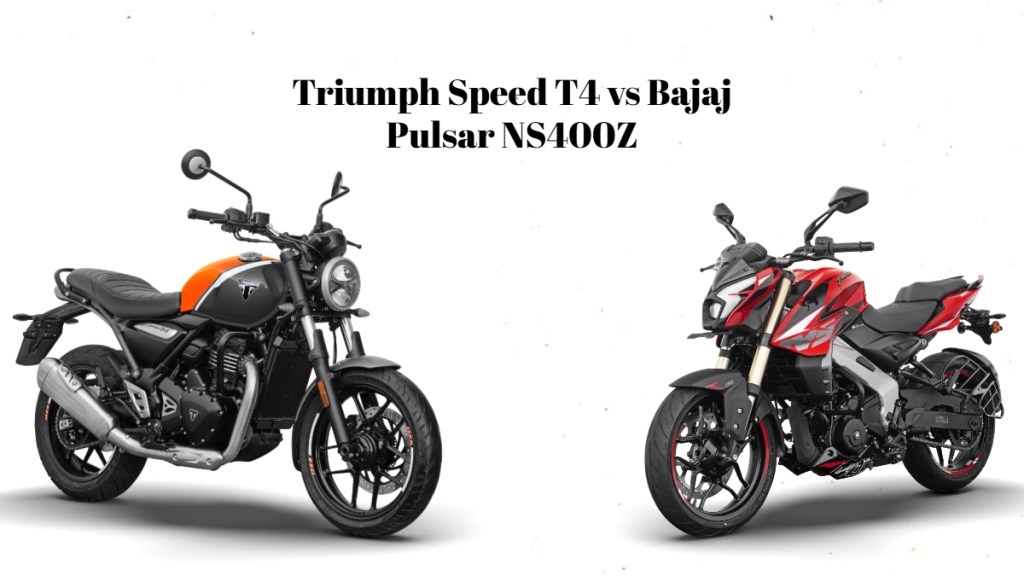Bajaj recently provided the Pulsar NS400Z with a critical set of upgrades just a year after its launch. The flagship Pulsar was by far the most affordable model in the 400cc segment at time of its launch, which made it a very enticing option. With this latest update, the Pulsar NS400Z has taken the standards a notch higher. Let us find out how the updated Pulsar NS400Z fares against one of its strongest rivals — Triumph Speed T4.
Bajaj Pulsar NS400Z vs Triumph Speed T4: Dimensions
| Dimensions | Bajaj Pulsar NS400Z | Triumph Speed T4 |
| Wheelbase (mm) | 1,344 | 1,406 |
| Fuel Tank Capacity (litres) | 12 | 13 |
| Ground clearance (mm) | 168 | 170 |
| Kerb weight (kg) | 174 | 180 |
| Seat height (mm) | 805 | 806 |
Physically, the Triumph Speed T4 is larger than the Pulsar NS400Z. Not only does it weigh more but also the Speed T4 offers a much longer wheelbase. The rest of the dimensions are very much alike. That said, Bajaj hasn’t revealed the exact length and width of the Pulsar NZ400Z yet.
Bajaj Pulsar NS400Z vs Triumph Speed T4: Features
The 2025 iteration of Pulsar NS400Z comes equipped with a fully-digital coloured LCD instrument panel which is packed with Bluetooth connectivity for call and text alerts, turn-by-turn navigation, music control, a lap timer, and traction control. Other notable feature highlights include full LED illumination, USB charging port, and multiple riding modes including rain, road, off-road, and sports.
The Speed T4, on the other hand, is a little bit more modest when it comes to features with highlights including a part-digital, part analogue instrument cluster, USB charging port, and an LED headlamp.
Bajaj Pulsar NS400Z vs Triumph Speed T4: Hardware specs
| Specifications | Bajaj Pulsar NS400Z | Triumph Speed T4 |
| Chassis Type | Steel Perimeter frame | Hybrid Spine, Tubular Steel, Bolt-on Subframe |
| Front Suspension | 43 mm upside down | Telescopic forks |
| Rear suspension | Monoshock with preload adjustment | Monoshock with preload adjustment |
| Front Brake | 320 mm disc | 300mm disc |
| Rear brake | 230mm disc | 230mm disc |
| Front Tyre | 110/70-R17 | 110/70-17 |
| Rear Tyre | 150/70-R17 | 140/70-17 |
| Safety | Dual-channel ABS | Dual-channel ABS |
In terms of hardware too, the Pulsar trumps over the Triumph with the addition of upside down front forks and wider radial tyres. The NZ400Z also gets a slightly larger front disc brake that should ideally offer better stopping power over the Speed T4.
Bajaj Pulsar NS400Z vs Triumph Speed T4: Engine & Performance
| Specifications | Bajaj Pulsar NS400Z | Triumph Speed T4 |
| Engine displacement | 373cc | 398cc |
| Engine type | Single-cylinder liquid-cooled, DOHC | Single-cylinder liquid-cooled, DOHC |
| Max Power | 42 bhp @ 8,800 rpm | 30.6 bhp @ 7,000 rpm |
| Max Torque | 35 Nm @ 6,500 rpm | 36 Nm @ 5,000 rpm |
| Transmission | 6-speed | 6-speed |
| Top Speed | 157 kmph | 135 kmph |
With the recent update, the Pulsar NS400Z continues to punch above its weight offering better output and performance as compared to the Speed T4. The Pulsar offers much more power than the Speed and more importantly a much better power-to-weight ratio since it’s 6 kilos lighter than the latter. As a result, the 400cc Pulsar has a higher top speed of 157 kmph. Peak torque on paper is almost similar for both naked roadsters.
Bajaj Pulsar NS400Z vs Triumph Speed T4: Price & Verdict
With the latest update, Bajaj has increased prices of the Pulsar NS400Z by Rs 7,000. Despite this increase, it’s still more affordable than the Speed T4. Moreover, the flagship Pulsar offers better features, specifications, and performance as compared to the Speed T4 that too at a lower price. This makes the Bajaj Pulsar NS400Z a clear winner over the Triumph Speed T4, at least on paper.
| Bajaj Pulsar NS400Z | Triumph Speed T4 | |
| Ex-showroom price | Rs 1.92 lakh | Rs 1.99 — 2.05 lakh |
